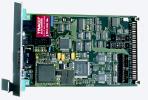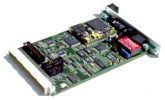ScanMaster2 - Board Revision 2
Laser projector control board, successor of the ScanMaster1. The board is an easy-to-use
embedded system for controlling an entire laser projection system. It lets client computers
stream data with standard ethernet and TCP/IP instead of using analog signals with bulky
and lossy cable connections. The use of standard computer interfaces further eliminates the
need for special hardware to be used with the signal source. For standalone operation,
the board offers media playback from memory and user interaction through input devices
connected to DMX512.
The board can be mounted directly into the projector, be run in a standalone adapter box or
be used in recording and playback systems. It comes with an ISP input, outputs and inputs
for galvo positioning and monitoring, 8 color outputs and several digital I/Os, connected to
a powerful DSP.
Revision 2 enhancements
Significant DSP bus traffic enhancements and speedups as well as logic circuitry
reduction through the use of a CPLD.
Fully implemented ISP (ILDA Standard Projector) input. The existing input port has
been enhanced with the user defined signals of the ISP standard. The signals are used
for additional colors, beam brush and stereoscopic applications.
Addition of a 512 Byte board EEPROM for configuration and calibration data.
Additional, separate headers for DMX512 I/O, ISP input and analog projector outputs
for improved projector wiring.
The board won the 2001 Fenning Award for Technical Achievement of the ILDA (International
Laser Display Association). First place was a tie of Schneider Showlaser and Lasershow
Converter Max of Pangolin, second place was ScanMaster2, third place was Lacon-5
Multimedia Workstation of LOBO.



The board supports different data sources. In frame oriented mode multiple data sources
and their streams of frames can be combined through the use of output windows. In stream
mode, the output and its timing is controlled by a stream of samples, originating from
network or the ISP input. Data sources are:
StageNet's SDCP/SMXP protocols via ethernet and TCP, UDP, IP. See StageNet.org for
more information. All ScanMaster2 interfaces can be accessed with the protocols and
any client can open sessions and exchange data with the unit. For management a
reliable TCP stream is used, for realtime data either UDP or TCP can be used.
ISP (ILDA Standard Projector) input. ISP is an analog projector interface specified by
ILDA. The ISP input can further be used for show recording. With StageNet's stream
mode the data can be transmitted to the client computer and be stored there.
Memory mode, where a series of user-supplied frames can either be played back from
internal storage continuously from switch-on to switch-off or be controlled from a
lightning desk with DMX512. The projector can be used to emulate moving lights with
stored frames taking the place of gobos.
The ease of use, the scalability through 10/100MBit ethernet, the versatile usage, its rich
feature set and its tiny size make this boad unique in the whole laser industry. The ability
to process the rendering of lines and curves in realtime puts new freedom into the hands of
show designes. Now, instead of doing the dot monkey, being able to use convenient strokes
and let ScanMaster do the timing. All this with space requirements far less than what is
needed by optics, drivers and power supplies.
System Features
Realtime interpolation of curves and vectors with variable output timing. This includes
color transformation, color morphing, geometry correction and calculation for galvo
scanner dynamics.
Colorspace converter accepts arbitrary colorspace coordinates and does on-the-fly conversion
to the coordinatespace used by the underlying hardware.
Capable of managing multiple output windows with one pair of scanners. Each window
can receive its own frame rate from the client.
Fully supports StageNet's multi-client concept. Multiple clients can connect to the
unit and exchange data. ScanMaster2 synchronizes the output transparenty.
ISP input and output (through voltage level adaper board). The input can be used for
easier migration of existing analog systems.
Advanced, redundant hardware-safety concept with interlock, shutter and blanking
outputs monitored by seperate watchdog circuitry. Additionally, all safety relevant
signals can be enabled by a single external signal, which is monitored by the CPU to
notify the user of the
occurence.
Hardware Features: PowerPC Subsystem
10/100MBit twisted pair ethernet with autonegotiation.
DMX512 input and output.
secondary DMX512 input and output dedicated for use with the ISP I/O feature.
I2C System expansion bus for communication inside the projector.
RS232 monitor for basic setup through terminal software.
Aux RS232 port for communication with other external devices.
3 LEDs for simple diagnostics
4 digital I/O's
512 Byte serial board EEPROM for system configuration.
66 MHz system clock, 16 MByte SDRAM and 8 MByte flash ROM system memory.
Hardware Features: DSP Subsystem
4x16 Bit D/A (X,Y command, 2 aux).
4x12 Bit A/D (X,Y position, 2 aux).
8x8 Bit D/A (Color, Brush, ...).
8 digital outputs, 4 digital inputs.
Fully implemented ISP (ILDA Standard Projector) input: X, Y, R, G, B, Intensity, User1-4
(10x16 Bit differential, 60kHz or 30kHz sampling frequency), Interlock, Shutter.
DMX512 handled by the PowerPC subsystem.
The outputs can be set up for use as ISP output. An optional adapterboard is needed to
provide voltage levels required by ILDA.
Dynamically adjusting on-the-fly interpolation of 10,000 - 100,000 points per second.
Powerful 100MHz DSP with 128KByte of 0-wait high speed RAM.
Hardware Features: Board
3-CPU system with a total processing power of approx. 250 MIPS.
High-speed parallel data link between processor subsystems.
Jumper free and fanless operation.
Single +5V power supply.
Clean and stabilized power supplies for all analog circuitry.
100x160mm form factor, 4 layer board, single side mounted, height: 20mm (4HP).
The main software consists of 2 logical code blocks. The operating system along with the
protocol handlers located on the PowerPC and the ScanEngine code located on the DSP. Both
are connected using a high speed 20MB/s parallel data link. A separate protocol isolates
this communication from the protocol used on the network.
Unlike most other systems ScanMaster2 does point calulation on the fly. Frames arriving
from the network are transformed according to the settings of their associated window and
color space conversion is done. Now, interpolation runs over lines and curves and calculates
color morphing and line styles with the galvo's maximum step increment.
With the interpolated points, an optimizer takes care of sharp edges and maximum velocity
through variable timing calculation. The rest of the pipeline is power processing, savety
zone control, geometry correction, galvo command output and galvo safety monitoring.
|




